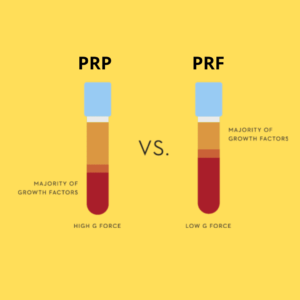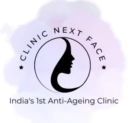Table of Contents
ToggleTL;DR
- PRP and PRF are non-surgical skincare treatments that use the body’s natural healing power.
- PRP uses platelet-rich plasma, while PRF uses platelet-rich fibrin, which contains a higher concentration of platelets and fibrin.
- PRF treatment requires less blood collection and does not use anticoagulants.
- PRF has a slower centrifuge process, resulting in the presence of stem cells and white blood cells in the serum.
- PRF provides a more effective and longer-lasting treatment than PRP, with benefits such as improved healing and release of growth factors at a slower rate.
PRP or Platelet-Rich Plasma treatment, is a popular non-surgical treatment in skincare. This treatment has been around for a long time. It is regarded by many as the go-to treatment for many skin conditions. Many skin problems from wrinkles to acne and scarring can be treated with PRP.
In the past few years though, a new treatment is making waves in medical aesthetics. Platelet-Rich Fibrin or PRF is the new treatment that has many dermatologists buzzing. This new iteration of PRP shares many similarities with its predecessor. There are some major differences though, which make PRF quite appealing.
What is PRP Treatment?
PRP Treatment is a non-intrusive skincare treatment that uses your body’s natural healing power. This is done by extracting the plasma from your blood. This plasma is then run through a centrifuge to separate the platelets.
The platelets are then reintroduced into the desired part of your skin to begin the process. PRP rejuvenates the skin and improves natural collagen production along with other proteins.
This treatment can be used to reverse skin problems or promote better healing of wounds.
What is PRF Treatment?
PRF Treatment works the same as PRP with one major difference. Instead of platelet-rich plasma, this treatment uses platelet-rich fibrin. Fibrin is an essential blood protein that promotes healing and clotting.
The centrifuge process is more intensive to extract and enrich the fibrin in the blood. PRF contains a higher concentration of platelets as well. The process itself takes less than an hour per session. The entire treatment takes about 2 to 4 sessions.

Why choose PRF instead of PRP for Face?
While PRP and PRF treatments are quite identical, there are a few differences in preparation and administration. The few but major differences between PRF and PRP make the former much more desirable.
Sample Collection:
Blood is the key component in both treatments. It is used to both analyze your skin and to create the serum. The quantity of blood collected varies a lot.
PRF treatment needs very little blood (around 20 to 60 ml) compared to PRP. This minimizes the chance of any side effects and complications with the extraction.
Use of Anticoagulants:
Anticoagulants are used in the preparation of PRP serum. Citrate dextrose or sodium citrate is among the more popular coagulants used. These anticoagulants ensure that the blood does not clot soon. This is also done to preserve the cell structure.
No anticoagulants are used in PRFs, though. Fibrin is formed in clotting blood and the use of anticoagulants could hinder that. The thrombin and fibrinogen in the blood help release the fibrin. This is also the natural process that occurs in the body after an injury.
Due to the rich content of fibrin, the growth and healing process is much faster.
Platelet Concentration:
In both PRP and PRF platelets play a huge role. PRF’s extraction process is quite effective in producing a higher concentration of platelets. But, the centrifuge process which is quite fast releases a lot of these platelets from the blood. This in turn reduces the concentration.
With PRP the centrifuge process is quite slow. This ensures that a higher concentration of platelets remains in the final solution. PRF serums usually contain up to ten times more platelets than in normal blood.
The Centrifuge:
The key difference between PRF and PRP is the isolation process. The blood is spun in a centrifuge at a defined speed to separate the platelets and stem cells.
With PRF the centrifuge uses a higher speed. This sends the heavier white and red blood cells to the lower part of the test tube and allows the platelets and plasma to float above.
Only the lighter part of the solution is used in the serum. This causes a loss of stem cells which are heavier than the plasma and are left out.
PRF is a much slower process and involves a slower speed of the centrifuge. This ensures that the plasma and platelets are not completely separated from the white blood cells. The result is the presence of fibrin, stem cells, and white blood cells in the serum.
The Treatment:
Each of the serums despite their similarities works quite in a very different manner. The production process of PRP is fast and the serum is quite thin due to the use of anticoagulants. This ensures a quick release of the growth factors at a higher quantity.
The healing process thus with PRP is quite fast but due to the lack of other growth factors is incomplete. The effect of the serum is also for a shorter period.
With PRF, the higher concentration of plasma and presence of stem cells, etc. provide a more effective treatment. Since the solution is quite thick, the growth factors are released at a slower rate. This ensures that the effect of the serum lasts a longer period.
| PRF | PRP |
| They’re an autologous platelet concentrate made using a patient’s blood and making it rich in growth factors, platelets, and fibrin. |
They’re an autologous platelet concentrate made using a patient’s blood and making it rich in growth factors and platelets. |
| During spinning the patient’s blood in a centrifuge, PRF is processed at a significantly slower rate. |
During spinning the patient’s blood in a centrifuge, PRP is processed at a significantly faster rate. |
| As such, PRF is rich in healing factors such as white blood cells, stem cells, and fibrin. |
Due to the high speeds, most heavy components sink to the bottom while lighter components such as platelets and plasma can be recovered to make PRP. |
| The final PRF solution has a greater number of platelets due to the slower processing speed. |
The final PRP solution has a lower number of platelets which are also lighter due to the faster processing speed. |
| Clots are allowed to be formed during the processing of PRF |
Anticoagulants are used to prevent clotting during the processing of PRP |
| The fibrin concentration causes the PRF solution to be in the form of a matrix or scaffold. This enables the platelets to be released at a much slower rate. |
Due to the usage of anticoagulants and the lack of fibrin in the final PRP product, PRP is known to release the platelets and growth factors at a much faster rate. |
PRF vs PRP Under Eyes
Your under-eye tissues are the thinnest body part and thus, they show aging signs much earlier than your other body parts. PRF treatment is the latest science therapy that uses your body’s natural growth hormones to tighten loose skin and remove dark circles and fine lines and give you tighter and brighter under eyes. PRF is an advanced blood concentration therapy with significant benefits over PRP. PRF uses low centrifugation to retain the vitality of WBCs and build a higher concentration of fibrin, platelets, and natural growth factors in a top tube layer.
PRP doesn’t contain stem cells and fibrin scaffolding. Once we inject this mixture under your eyes with a micro-cannula to minimize bruising, it boosts elastin and collagen production to enhance skin tone, elasticity, and firmness to give you a well-rested and youthful look even if you lack sleep. The repair and regeneration of new and healthy skin tissues will continue for two to three months and deliver natural and long-term results. The absence of anticoagulants or additives helps in creating fibrin scaffolds that increase the activeness of cells.
Your blood’s growth factors release more slowly in a few days than hours, which makes them immediately available in your skin repairing and regeneration process. It helps in boosting the overall health and appearance of your under-eye area by lightning fine lines and pigmentation. PRF’s gel-like consistency works well with HA fillers. The combination of PRF and fillers gives a natural fullness to your eyes and reduces the need for fillers in the future because of skin health improvement over time.
What Makes CNF The Best Clinic To Get PRF Done?
At CNF we have a great track record of administering effective PRF treatments. Our treatments have earned us the patronage of many satisfied clients. We are the only clinic to offer PRF in the city of Bangalore. We also ensure that the process is painless and no side effects are found.
Our in-house PRF expert Dr. Praharsh is one of the very few specialists who offer this treatment in India. He also conducts research with many experts around the world to produce better PRF serums.
Dr. Prahash’s study on PRF allows CNF to offer a safe and effective PRF treatment to help you with any issue.
Fill this form below for getting a free consultation with doctor regarding PRF treatment.
Talk To Our Hair Loss Expert Today!
No Obligations! Just jump on a quick call with our hair loss expert and know what kind of treatment will suit you the best.
Either way you will get some actionable tips to reach your hair goals faster.








